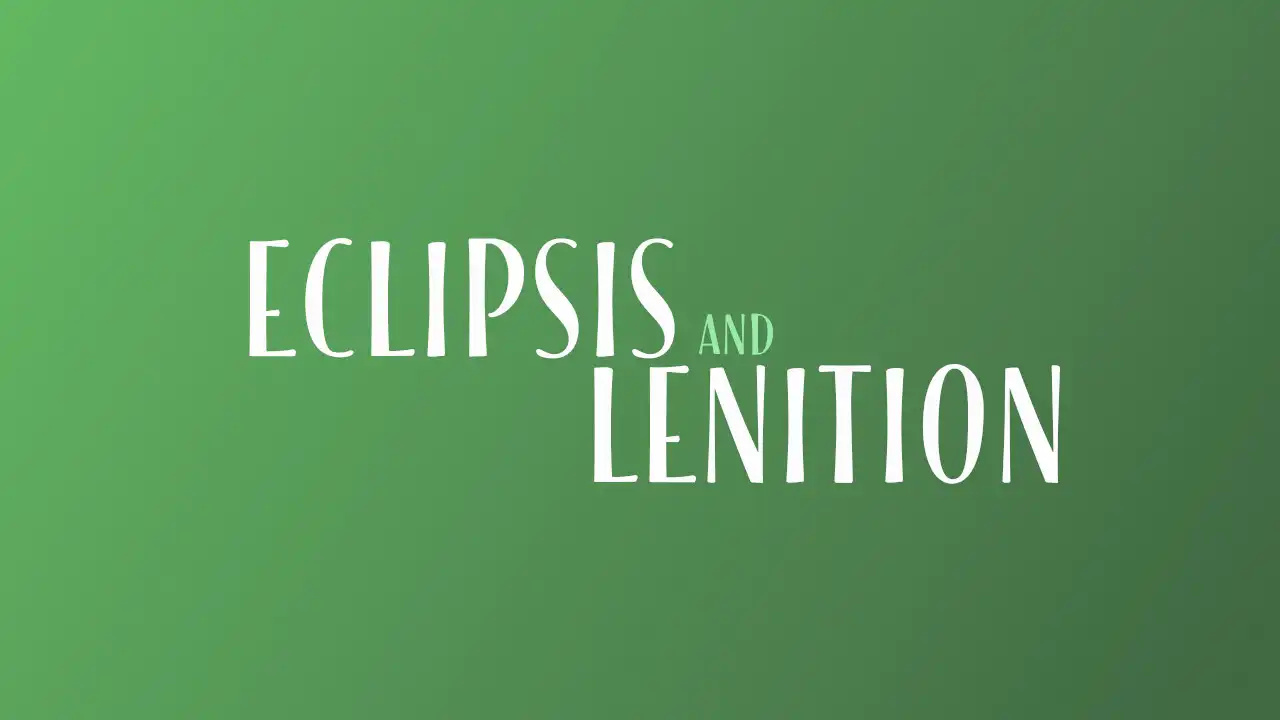A Beginner's Guide to Irish Initial Mutations: Lenition and Eclipsis
Author

Dia dhaoibh, a chairde!
When you first start learning Gaeilge, you might notice something strange happening to the first letters of words. A cat (cat) suddenly becomes a chat, and a bád (boat) can turn into a mbád. What’s going on here?
Welcome to the world of initial mutations!
I know, the word ‘mutation’ sounds a bit scary, like something from a science fiction movie. But in Irish, it’s just a fancy way of saying that the first letter of a word sometimes changes to make sentences flow more smoothly. It’s one of the most unique and beautiful parts of the language.
Don’t worry, you don’t need to memorize a giant rulebook right away.
Today, we’re going to break down the two most common types of mutation in a simple way: Lenition (séimhiú) and Eclipsis (urú).
Table of Contents:
What are initial mutations?
At its core, an initial mutation is a change to the first letter of a word. This change is usually caused by the word that comes just before it. Think of it like a domino effect in grammar.
We actually have something a little similar in English. We say “a pear” but “an apple”. The word ‘an’ is used before a vowel sound to make it easier to say. Irish mutations work on the same principle: they make the language sound more melodic and natural.
The two main types you’ll see everywhere are lenition (séimhiú) and eclipsis (urú). Let’s look at them one by one.
Lenition (séimhiú) - the ‘softening’ mutation
Lenition is called séimhiú (pronounced ‘shay-voo’) in Irish, which means ‘softening’. And that’s exactly what it does—it softens the sound of a consonant.
How does it work? Simple! You just add an ‘h’ after the first consonant of the word.
Here are the letters that can be lenited:
| Original | With Lenition | Example Sound |
|---|---|---|
| b | bh | ’v’ or ‘w’ sound |
| c | ch | throaty ‘h’ sound (like Scottish ‘loch’) |
| d | dh | guttural ‘y’ or ‘gh’ sound |
| f | fh | Silent! |
| g | gh | guttural ‘y’ or ‘gh’ sound |
| m | mh | ’v’ or ‘w’ sound |
| p | ph | ’f’ sound |
| s | sh | ’h’ sound |
| t | th | ’h’ sound |
Let’s look at a few examples in action. One of the most common triggers for lenition is the possessive adjective ‘my’, which is mo.
cat
mo chat
See how cat becomes chat? The hard ‘c’ sound is softened. Another very common trigger is addressing someone directly (this is called the vocative case). You put A before their name and lenite it.
Dia dhuit, a Phádraig!
Here, the ‘p’ in Pádraig gets an ‘h’ and becomes a ‘ph’ sound, which sounds like ‘f’.
Eclipsis (urú) - the ‘eclipsing’ mutation
Our second mutation is eclipsis, or urú (pronounced ‘uh-roo’) in Irish. The word urú means ‘eclipsing’ or ‘covering up’.
Instead of softening the sound, eclipsis completely covers up the original sound with a new one.
How does it work? A new letter is placed at the very beginning of the word, and you only pronounce the new letter. The old one is still written there, but it goes silent—it’s been eclipsed!
Here are the consonants that can be eclipsed:
| Original | With Eclipsis | Pronounced As |
|---|---|---|
| b | mb | m |
| c | gc | g |
| d | nd | n |
| f | bhf | v / w |
| g | ng | ng (like in ‘sing’) |
| p | bp | b |
| t | dt | d |
One of the most common places you’ll see eclipsis is after the word ár (our).
teach
ár dteach
Notice how the ‘d’ is added before the ‘t’? We now pronounce the ‘d’ sound at the start of the word. The ‘t’ sound is gone!
Another common trigger is after numbers 7-10.
bád
seacht mbád
Here, bád becomes mbád, and we pronounce it as if it starts with ‘m’.
A quick summary
I know this can feel like a lot at first, but let’s boil it down to the basics:
- Lenition (Séimhiú): Adds an ‘h’ to soften the sound (e.g., cat -> mo chat). It’s like turning the volume down a bit.
- Eclipsis (Urú): Adds a new letter at the front to change the sound completely (e.g., peann -> ár bpeann - our pen). It’s like changing the channel.
The most important thing to remember is that you don’t have to be perfect from day one. The more you read and listen to Irish, the more natural these changes will feel. Your brain will start to recognize the patterns without you even having to think about it.
So there you have it—your first look into the world of Irish initial mutations! It’s a core feature of the language that, once you get the hang of it, makes speaking and understanding Gaeilge so much more rewarding.
Don’t be overwhelmed. Start by noticing these changes when you see them. The ‘why’ will become clearer over time. Keep practicing, and soon séimhiú and urú will be second nature.
Go n-éirí leat! (Good luck!)